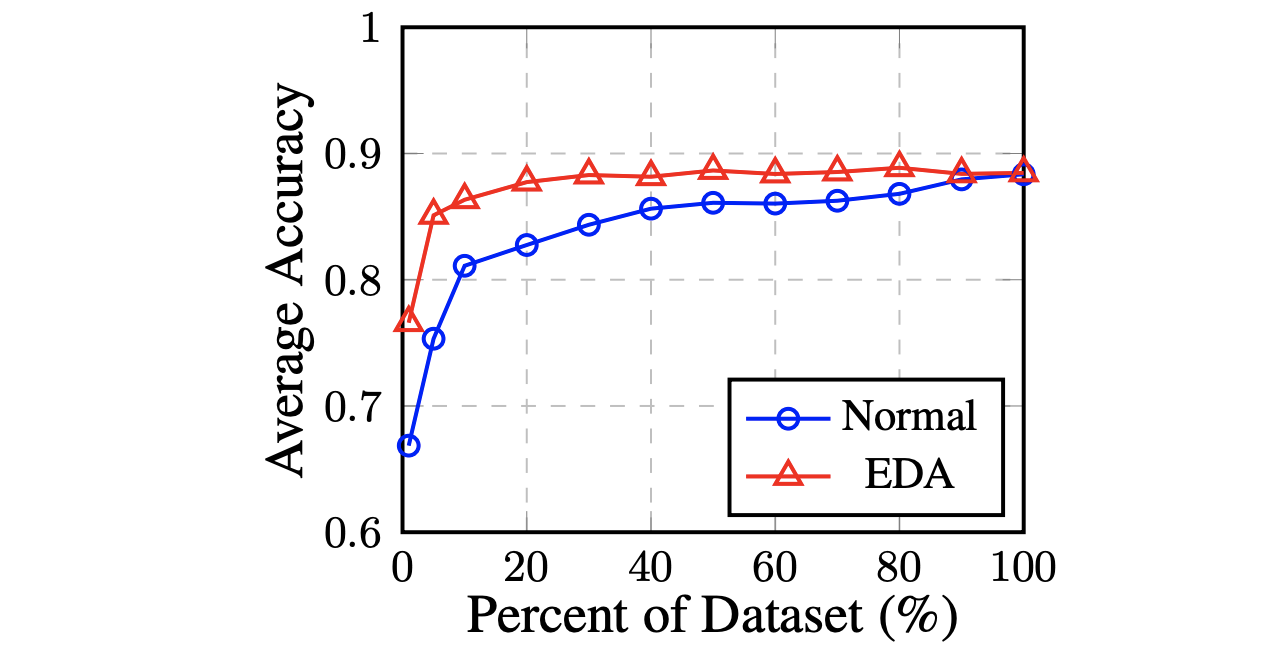This is the code for the EMNLP-IJCNLP paper EDA: Easy Data Augmentation techniques for boosting performance on text classification tasks.
A blog post that explains EDA is [here].
By Jason Wei and Kai Zou.
Note: Do not email me with questions, as I will not reply. Instead, open an issue.
We present EDA: easy data augmentation techniques for boosting performance on text classification tasks. These are a generalized set of data augmentation techniques that are easy to implement and have shown improvements on five NLP classification tasks, with substantial improvements on datasets of size N < 500. While other techniques require you to train a language model on an external dataset just to get a small boost, we found that simple text editing operations using EDA result in good performance gains. Given a sentence in the training set, we perform the following operations:
- Synonym Replacement (SR): Randomly choose n words from the sentence that are not stop words. Replace each of these words with one of its synonyms chosen at random.
- Random Insertion (RI): Find a random synonym of a random word in the sentence that is not a stop word. Insert that synonym into a random position in the sentence. Do this n times.
- Random Swap (RS): Randomly choose two words in the sentence and swap their positions. Do this n times.
- Random Deletion (RD): For each word in the sentence, randomly remove it with probability p.
You can run EDA any text classification dataset in less than 5 minutes. Just two steps:
Pip install it.
pip install -U nltkDownload WordNet.
python
>>> import nltk; nltk.download('wordnet')You can easily write your own implementation, but this one takes input files in the format label\tsentence (note the \t). So for instance, your input file should look like this (example from stanford sentiment treebank):
1 neil burger here succeeded in making the mystery of four decades back the springboard for a more immediate mystery in the present
0 it is a visual rorschach test and i must have failed
0 the only way to tolerate this insipid brutally clueless film might be with a large dose of painkillers
...
Now place this input file into the data folder. Run
python code/augment.py --input=<insert input filename>The default output filename will append eda_ to the front of the input filename, but you can specify your own with --output. You can also specify the number of generated augmented sentences per original sentence using --num_aug (default is 9). Furthermore, you can specify the alpha parameter, which approximately means the percent of words in the sentence that will be changed (default is 0.1 or 10%). So for example, if your input file is sst2_train.txt and you want to output to sst2_augmented.txt with 16 augmented sentences per original sentence and alpha=0.05, you would do:
python code/augment.py --input=sst2_train.txt --output=sst2_augmented.txt --num_aug=16 --alpha=0.05Note that at least one augmentation operation is applied per augmented sentence regardless of alpha. So if you do alpha=0.001 and your sentence only has four words, one augmentation operation will still be performed. Best of luck!
If you use EDA in your paper, please cite us:
@inproceedings{wei-zou-2019-eda,
title = "{EDA}: Easy Data Augmentation Techniques for Boosting Performance on Text Classification Tasks",
author = "Wei, Jason and
Zou, Kai",
booktitle = "Proceedings of the 2019 Conference on Empirical Methods in Natural Language Processing and the 9th International Joint Conference on Natural Language Processing (EMNLP-IJCNLP)",
month = nov,
year = "2019",
address = "Hong Kong, China",
publisher = "Association for Computational Linguistics",
url = "https://www.aclweb.org/anthology/D19-1670",
pages = "6383--6389",
abstract = "We present EDA: easy data augmentation techniques for boosting performance on text classification tasks. EDA consists of four simple but powerful operations: synonym replacement, random insertion, random swap, and random deletion. On five text classification tasks, we show that EDA improves performance for both convolutional and recurrent neural networks. EDA demonstrates particularly strong results for smaller datasets; on average, across five datasets, training with EDA while using only 50{\textbackslash}{\%} of the available training set achieved the same accuracy as normal training with all available data. We also performed extensive ablation studies and suggest parameters for practical use.",
}
The code is not documented, but is here for all experiments used in the paper. See this issue for limited guidance.

